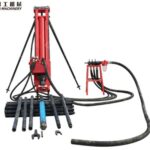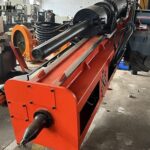Down the hole drilling rig, often abbreviated as DTH drilling machine, is a pneumatic or hydraulic drilling rig that uses a percussive mechanism to break rock formations. DTH machines utilize a hammer mechanism located just behind the drill bit. This hammer strikes the bit repeatedly as it rotates, enabling efficient fracturing of hard rock layers. The term “down the hole” refers to the positioning of the hammer within the borehole, ensuring minimal energy loss and maximum transfer of force to the drilling surface.
Components Of A Down the Hole Drilling Rig
Drill Bit
The drill bit is the cutting tool attached to the end of the drill string. Made from durable materials like tungsten carbide, it is engineered to withstand extreme abrasion and impact forces.
DTH Hammer
The hammer is the heart of the system, generating percussive energy to fracture the rock. Compressed air or hydraulic fluid powers the hammer, driving it to strike the drill bit at high frequency.
Drill Pipe
Hollow steel pipes connect the surface rig to the hammer and bit. These pipes transmit rotational torque, compressed air, and flushing media (air or water) to the bottom of the borehole.
How Does A DTH Drilling Machine Work?
Compressed air is channeled through the drill pipe to the down the hole drilling rig hammer.
The hammer’s piston reciprocates rapidly, striking the drill bit with high-energy blows.
Simultaneously, the rotation mechanism turns the drill string, allowing the bit to cut a circular path.
The spent air exits through ports in the bit, carrying rock fragments (cuttings) up the annular space between the drill pipe and borehole wall.
This cycle continues until the desired depth is achieved.
Advantages Of Using A DTH Drilling Machine
High Penetration Rates
The direct transfer of energy to the drill bit allows down the hole drilling rig to achieve faster drilling speeds in hard formations, reducing project timelines.
Precision And Accuracy
The stability of the drill string and minimal deviation ensure straight, uniform boreholes, critical for blasting and construction.
Versatility
DTH systems can adapt to varying rock hardness and borehole diameters by adjusting hammer pressure, bit design, and rotation speed.



